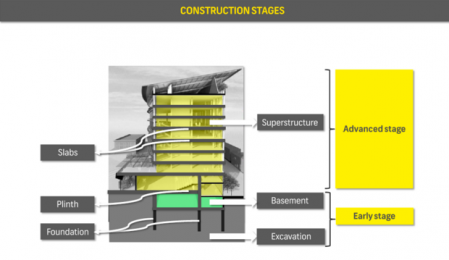Loading Factor :
Loading Factor can be defined as the area which includes the proportionate share of the common area for a flat which is determined by applying a multiplier to the carpet area. In general, builders include space around staircases and elevators as common areas while calculating the loading factor. Thus, loading factor, when combined with the carpet area, gives the super built-up area of a flat.
For example, if a builder puts 1.25 as the loading factor, then it means 25% of space has been added to the carpet area of the flat. If the carpet area of a flat is 500 square feet then the super built-up area of the flat can be calculated as:
500 square feet + 500 x 25% = 625 square feet.

OSR (Open Space Ratio) :
Open Space Ratio (OSR) is a terminology commonly used in the development of residential spaces. OSR is calculated by dividing the total amount of open space (which is commonly owned on the residential land parcel which is proposed for development) by the total area of the entire land parcel (which is proposed for development). Areas on private lots which are buildable and any commonly-owned open space that is less than 320 contiguous square feet are not counted as open spaces. Although, areas like parking lots and recreation areas are included in open spaces.
For example, if there are 4 acres of common open space and 8 acres of land parcel proposed for development, then the open space ratio is 50%.
FSI (Floor Space Index) :
FSI, meaning Floor Space Index, also known as Floor Area Ratio (FAR), is the ratio of total built-up area to the total area of the plot. The municipal council of a particular area is responsible for establishing the FSI limit in a certain range in order to regulate the amount of construction and the size of the buildings in that area. Since FSI is a measure that combines the height and footprint of a building, regulating it ensures flexibility in the design of the building.
Construction Stages :
You may choose to stay away assuming that the various construction stages don’t concern you, but if your business involves an under-construction flat, these stages will definitely help you.
Knowing the real estate terms of all the stages in the building construction process and their significance will save you much trouble:
1) Mobilisation
Mobilisation is the process of making the plot ready for construction. The process generally involves building a fence around the plot, making necessary services available, transport of construction tools and equipment to the plot and building a shed for the labourers.
2) Ground Work
The process of levelling the ground of the plot, benchmarking and cleaning the plot comes under the phase of ground work.
3) Sub Structure Work
Sub structure work involves the construction of structures like the foundation, neck columns, grade beams, the ground floor, etc.
4) Super Structure Work
Super structure work involves the construction of the structures that are situated above the ground like columns, slabs, beams, staircases, etc.
5) Masonry Work
Masonry work is a phase in which everything comes into shape and gets a face. It involves plaster work and levelling of the walls and ceilings. This stage is what prepares the project for the services work.
6) Services Work
Services work includes electrical work, sanitary work, plumbing work, etc. It involves fixing lights and fans, bathroom fittings, toilet equipment and anything else that would be provided by the builder.
7) Finishing Work
At this stage, it is time to give the final touch to the property. It involves painting and any kind of carpentry work like doors, door frames and, in some cases, false wooden ceilings.
8) Completion
Completion stage of the building construction process involves cleaning of the built property, final inspection and handover of the property to the buyer.
We hope these terms solve all the confusions you had regarding realtor jargons when it comes to starting a construction. If you have more questions, ask us!
Property Knowledge By Autoscale




